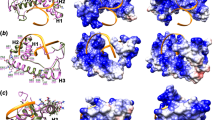Abstract
Histoplasma capsulatum is a pathogenic dimorphic fungus which causes histoplasmosis in animals and man. The free-living saprobic form found in soil is mycelial, but, on infection, or in the laboratory, when the temperature is raised from 23 to 37 °C, it converts reversibly to a unicellular, parasitic yeast-like form. Little is known about the biochemistry of this process. There have been reports of quantitative and qualitative differences in the chemical composition of the two forms1,2, and of changes in RNA metabolism during the conversion3. Also, whereas extracts from the yeast phase cells contain multiple species of RNA polymerase, those from mycelia have only traces of activity, but contain an inhibitor of RNA polymerase4. The yeast and mycelial cells differ in sensitivity to amphotericin B (a polyene) and actinomycin D5, but there is no significant enzymatic difference between the two phases with respect to the glycolytic pathway and the tricarboxylic acid cycle6. The initiation of conversion requires a temperature change and also low oxidation–reduction potential (O/R) of the growth medium7, but the maintenance of the yeast phase requires sulphur-containing organic compounds, especially cysteine8,9. The possibility of a nutritional requirement for –SH groups has been suggested10 but not explored. We now report that the yeast cells lack the enzyme sulphite reductase so that they cannot reduce inorganic sulphite to sulphide, and thus cannot synthesise cysteine. In contrast, mycelial cells, with active reductase, can grow without cysteine supplement.
This is a preview of subscription content, access via your institution
Access options
Subscribe to this journal
Receive 51 print issues and online access
$199.00 per year
only $3.90 per issue
Buy this article
- Purchase on Springer Link
- Instant access to full article PDF
Prices may be subject to local taxes which are calculated during checkout
Similar content being viewed by others
References
Cino, P. M., and Tewari, R. P., Mycopath. Mycol. Appl., 47, 285–294 (1972).
Domer, J., Hamilton, J. G., and Harkin, J. C., J. Bact., 94, 466–474 (1967).
Cheung, S.-S. C., Kobayashi, G. S., Schlessinger, D., and Medoff, G., J. gen. Microbiol., 82, 301–307 (1974).
Boguslawski, G., Medoff, G., Schlessinger, D., and Kobayashi, G. S., Biochem. biophys. Res. Commun., 64, 625–632 (1975).
Cheung, S.-S. C., Medoff, G., Schlessinger, D., and Kobayashi, G. S., Antimicrob. Agents Chemother., 8, 498–503 (1975).
Mahvi, T. A., J. infect. Dis., 115, 226–232 (1965).
Rippon, J. W., Appl. Microbiol., 16, 114–121 (1968).
Scherr, G. H., Expl Cell Res., 12, 92–107 (1957).
McVeigh, I., and Houston, W. E., Mycopath. Mycol. Appl., 47, 135–151 (1972).
Garrison, R. G., Dodd, H. T., and Hamilton, J. W., Mycopathology, 40, 171–180 (1970).
Boguslawski, G., Kobayashi, G. S., Schlessinger, D., and Medoff, G., J. Bact., 122, 532–537 (1975).
Akagi, J. M., and Adams, V., J. Bact., 116, 392–396 (1973).
Author information
Authors and Affiliations
Rights and permissions
About this article
Cite this article
BOGUSLAWSKI, G., AKAGI, J. & WARD, L. Possible role for cysteine biosynthesis in conversion from mycelial to yeast form of Histoplasma capsulatum. Nature 261, 336–338 (1976). https://doi.org/10.1038/261336a0
Received:
Accepted:
Published:
Issue Date:
DOI: https://doi.org/10.1038/261336a0
This article is cited by
-
Comparison of Biological Indicators of Soil Quality of Horticultural Crops Based on No-tillage and Non-synthetic Systems
Erwerbs-Obstbau (2023)
-
Cell organisation, sulphur metabolism and ion transport-related genes are differentially expressed in Paracoccidioides brasiliensis mycelium and yeast cells
BMC Genomics (2006)
-
Endogenous elemental sulfur production froml-cysteine in dormant α-spores ofPhomopsis viticola
Current Microbiology (1988)
-
Selenocystine-resistant mutants of Histoplasma capsulatum
Mycopathologia (1981)
-
Aspects of physiology of Histoplasma capsulatum (A review)
Mycopathologia (1979)
Comments
By submitting a comment you agree to abide by our Terms and Community Guidelines. If you find something abusive or that does not comply with our terms or guidelines please flag it as inappropriate.



